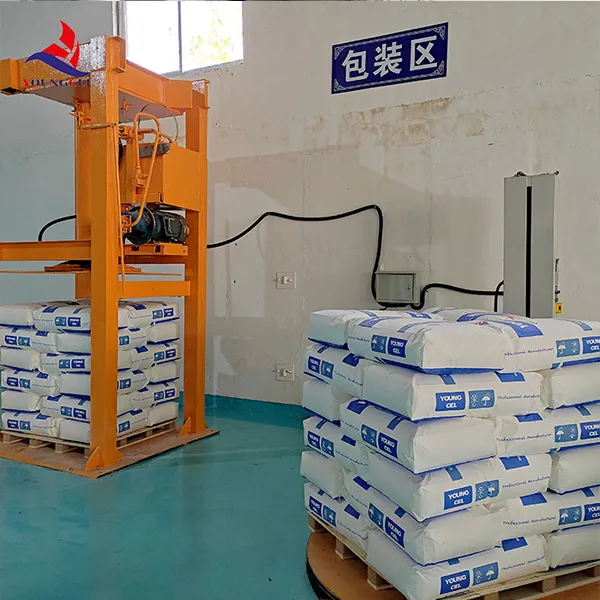Understanding Hydroxypropyl Methyl Cellulose (HPMC) A Versatile Polymer
Hydroxypropyl Methyl Cellulose (HPMC) is a non-ionic, water-soluble polymer derived from cellulose, a natural polymer obtained from plant cell walls. Its unique properties make it an essential ingredient in various industries, including pharmaceuticals, food, cosmetics, and construction. The combination of its hydrophilic nature and film-forming abilities allows HPMC to function effectively as a thickening agent, stabilizer, and emulsifier, among other applications.
1. Composition and Properties
HPMC is synthesized through the chemical modification of cellulose. By substituting hydroxyl groups in the cellulose structure with hydroxypropyl and methyl groups, HPMC acquires its distinctive characteristics. The degree of substitution and the molecular weight can be controlled during synthesis, allowing for the production of various grades of HPMC, each tailored for specific applications.
One of the key properties of HPMC is its ability to dissolve in hot or cold water to form viscous solutions. This solubility is a result of the hydrophilic functional groups present in its structure, which facilitate interactions with water molecules. The viscosity of HPMC solutions can be adjusted by changing the concentration of HPMC and the molecular weight of the polymer, making it a versatile agent in formulations.
2. Applications in Pharmaceuticals
In the pharmaceutical industry, HPMC is widely used as a binder, lubricant, and film-coating material in tablet formulations. Its non-toxic nature and biocompatibility make it suitable for use in various medicinal products. HPMC helps to improve the uniformity and stability of tablets, ensuring that active pharmaceutical ingredients (APIs) are evenly distributed.
Additionally, HPMC is utilized in controlled-release formulations, where it acts as a release rate modifier. When incorporated into matrix tablets, HPMC forms a gel-like barrier upon contact with gastrointestinal fluids, regulating the release of the drug over time. This property is particularly beneficial for chronic disease management, where consistent drug delivery is crucial.
3. Role in Food Products
hydroxypropyl methyl cellulose(hpmc)

In the food industry, HPMC serves multiple functions. It is commonly used as a thickening agent and stabilizer in sauces, dressings, and soups, enhancing viscosity while maintaining a desirable texture. Moreover, HPMC is often employed in gluten-free baking; it mimics the binding properties of gluten, helping to create elasticity and structure in dough.
In addition to its thickening properties, HPMC acts as an emulsifier, aiding in the stabilization of oil-in-water emulsions. This functionality is vital in products such as mayonnaise and salad dressings, where it helps prevent the separation of ingredients and maintains a uniform texture.
4. Use in Cosmetics
HPMC has found a significant place in the cosmetics industry, where it is used in the formulation of creams, lotions, and shampoos. Its film-forming ability allows it to create a smooth, protective barrier on the skin or hair, enhancing the product's aesthetic feel. HPMC also acts as a thickener in cosmetic formulations, providing the desired viscosity without imparting any unwanted aroma or color.
In skin care products, HPMC can help improve the moisturizer's application and absorption, contributing to a better overall user experience. Furthermore, its non-irritating properties make it suitable for sensitive skin formulations.
5. HPMC in Construction
The construction industry benefits from HPMC's properties as well. It is commonly added to cement and gypsum-based mortars, enhancing workability and water retention. This improves the performance of building materials, allowing for better adhesion and durability. HPMC also aids in extending the open time of applications, giving builders more flexibility during installation processes.
Conclusion
Hydroxypropyl Methyl Cellulose (HPMC) is a multifunctional polymer that plays a critical role across various sectors. Its versatility is attributed to its unique solubility, thickening, and emulsifying properties. Whether in pharmaceuticals, food products, cosmetics, or construction materials, HPMC continues to be an indispensable ingredient, offering numerous advantages that enhance product performance and user experience. As research and technology advance, the applications of HPMC are likely to expand further, solidifying its position as a key polymer in modern formulations.
-
Rdp that The Revolutionary Polymer Powder Transforming Modern Construction MaterialsNewsAug.11,2025
-
Hpmc Powder that Versatile Additive for Detergents and Personal CareNewsAug.11,2025
-
Hpmc Hydroxypropyl Methylcellulose that Essential Building Material Additive from Shijiazhuang Gaocheng YongfengNewsAug.11,2025
-
Hydroxypropyl Methyl Cellulos Hpmc that Essential for Construction ApplicationsNewsAug.11,2025
-
Mhec Powder that Revolutionizing Construction Chemistry with Cellulose Ether SolutionsNewsAug.11,2025
-
Industri Hpmc that The Global Backbone of Advanced ConstructionNewsAug.11,2025




